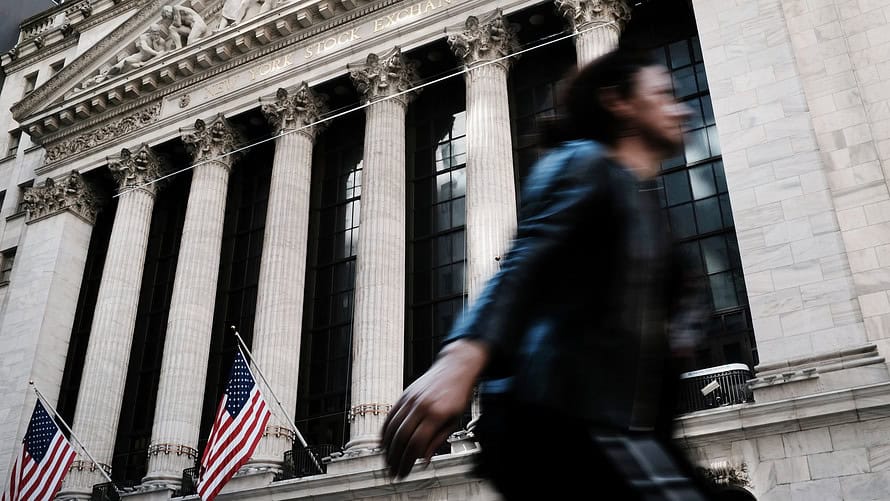
U.S. stocks closed firmly higher Wednesday, with two major indexes ending at records as equities extended a recent winning streak to a fourth straight session.
The day’s gains were broad based but led by financial stocks, which were the top-performing sector of the day as bond yields rose.
What did the markets do?
The Dow Jones Industrial Average DJIA, +1.40% rose 346.41 points, or 1.4%, to 25,146.39. Wednesday marked the blue-chip average’s biggest one-day point and percentage gain since April 10, and it closed at its highest level since March 12.
The S&P 500 SPX, +0.86% added 23.55 points, or 0.9%, at 2,772.35, also ending at its highest since March 12. The Nasdaq Composite Index COMP, +0.67% rose 51.38 points, or 0.7%, to 7,689.24, recording its third consecutive all-time closing high. Both the S&P and the Nasdaq posted a fourth straight daily advance, while the Dow has risen in three of the past four trading days.
The small cap-oriented Russell 2000 index RUT, +0.68% rose 0.7% in its fourth straight positive session.
Both the Nasdaq and the Russell closed at records, extending their relative outperformance on the year. The Nasdaq is up 11.4% in 2018 while the Russell is up 9.2%. To compare, the Dow is up 1.7% and the S&P has risen 3.7%.
The Cboe Volatility Index VIX, -6.13% fell 6.1% to 11.64, well below its long-term average between 19 and 20. The so-called “fear index” has dropped consistently of late, and it is poised to settle at its lowest level since Jan. 26. The VIX is down more than 13% thus far this week, and off 42% since the start of April.
What is driving the market?
The financial sector rose 1.8%, easily the biggest percentage gainer of the day. The sector was boosted in part by a rise in the yield of the benchmark 10-year Treasury note TMUBMUSD10Y, +0.26% which was supported by remarks from European Central Bank senior officials, which showed the central bank remained on track to debate the timetable for ending its asset purchases soon.
Yields rise as bond prices fall and climbing rates are generally bullish for banks’ business models.
Among the most notable gainers in the sector, JPMorgan Chase & Co. JPM, +2.34% climbed 2.3% and Goldman Sachs Group Inc. GS, +1.70% added 1.7%.
Investors remained on alert for developments surrounding trade policy. Treasury Secretary Steven Mnuchin reportedly urged President Donald Trump to exempt Canada from metals tariffs at a meeting Tuesday, and a separate report indicated that China offered to buy some $70 billion of U.S. goods to get the Trump administration to cool its tariff threats.
Tensions are still simmering, however, after Mexico revealed which U.S. products it is targeting for import tariffs—around $3 billion for goods, including apples and bourbon—in retaliation for U.S. duties on Mexican steel and aluminum.
Leaders of the Group of Seven nations will likely discuss trade as they hold talks in Canada on Friday and Saturday. Tension between the U.S. and the six other members is expected, given the hostile reactions to tariffs imposed by the Trump administration.
Among specific stocks, Tesla Inc. TSLA, +9.74% surged 9.7% after Chief Executive Elon Musk told shareholders that the electric-car maker was “quite likely” to meet its production goal of 5,000 Model 3 cars a week.
Facebook Inc. FB, -0.83% fell 0.8% after the social-media giant confirmed it had shared user data with at least four Chinese tech companies. U.S. officials have warned that devices from one of those companies — Huawei Technologies Co.— could be exploited for state-sponsored spying.
What are strategists saying?
“While investors continue to watch trade developments, it’s really the rise in bond yields that is supporting the market today. The indication that the ECB could reduce bond purchases as early as next week has allowed long-term rates to move up, and that’s driving financials higher, as higher rates support their outlook,” said Kate Warne, investment strategist at Edward Jones.
“We’re still in the stage of the economy where rising rates reflect stronger economic growth, as opposed to central banks trying to combat inflation. The ECB news is a relief rather than a worry.”
What’s on the economic calendar?
The U.S. trade deficit shrank 2.1% in April—before the Trump tariffs took effect—and tumbled to a seven-month low. But the gap is still on track to widen in 2018 to the highest level in a decade.
Meanwhile, the productivity of American businesses rose at a revised 0.4% annual pace in the first quarter instead of 0.7% as originally reported. Output—or goods and services produced—climbed 2.7% instead of 2.8%, while unit-labor costs, or how much it costs to make each product, rose by 2.9%, a bit higher than the preliminary 2.7% estimate, the government said Wednesday.
S&P 500’s biggest movers
The biggest percentage gainer for the benchmark U.S. index was Nektar Therapeutics NKTR, +7.18% =, which rose 7.2%. The stock has recently struggled following “underwhelming” results in a cancer-drug trial.
The biggest decliner was Brown-Forman Corp. BF.B, -6.09% which sank 6.1% in their biggest one-day percentage decline in more than a year. In an earnings call, company executives played down the potential effect of tariffs on bourbon imports.

